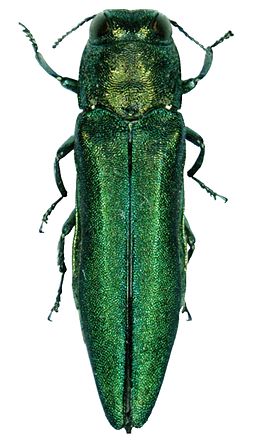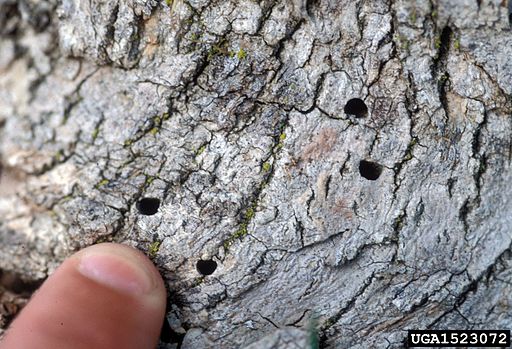The Emerald Ash Borer Becoimg a Local Threat
The Emerald Ash Borer (EAB) is a small metallic green beetle accidentally introduced to the United States in the early 2000s from Asia. From its introduction point near Detroit, it spread across the northern and eastern United States and was confirmed to have reached North Carolina in 2013. In 2015 it was identified in Guilford County. During its spread, the EAB has killed many millions of ash trees.
Emerald Ash Borer affects all species of native ash as well as native fringetree (Chionanthus virginicus, related to ash), and requires these trees to complete its life cycle. As of now, no other host species are known.
The adult beetle lays eggs on the bark of ash trees where the larvae burrow into the bark upon hatching. As the larvae grow, they create feeding galleries that disrupt the flow of water and nutrients within the tree. Once infected with EAB larvae, the tree quickly declines and usually dies within two to five years.
The adults spread by flying, but the EAB can only move a few miles per season this way. The real threat is the movement of firewood and other wood products by people that can increase the spread of this pest by hundreds of miles at a time. Adult Emerald Ash Borers can emerge from transported wood they were in as larvae and infect new areas.
Because ash trees are both an important component of our native forests and valuable ornamental and street trees, the unchecked spread of EAB will likely be devastating, recalling the destruction of the American chestnut by blight and elms by Dutch elm disease in the first half of the 20th century.
Diligent observation for and management of new areas of infestation are needed to slow the spread of EAB. If symptoms of infestation are observed early enough, landscape trees can be treated annually with systemic insecticide and be saved; this is not a viable or cost-effective strategy for infested forest trees and removal is the usual result.
Several species of stingless parasitic wasps that attack EAB have been studied as a biological control with some success, but as of yet populations of this wasp are too low to be considered an effective control measure.
To prevent infestation of ash trees in your landscape, annual preventive treatment with a systemic insecticide is recommended (1) when EAB has been confirmed within 10-15 miles of your property and is considerably less expensive than removing a killed ash tree, particularly if it is large. Be aware that untreated or unprotected trees in affected areas will eventually be killed by EAB. Since many of our local readers are within 10-15 miles of the known infested area in Guilford County, if you value your ash trees you should consider preventive treatment next spring.
According to the NCSU Cooperative Extension, the following are symptoms of infestation:
- Increased woodpecker activity – this is often the first sign
- Canopy dieback, thinning and leaf loss
- Epicormic shoots – vigorous shoots that sprout from the base and trunk of infested trees
- Bark splitting
- D-shaped exit holes in the trunk
(See images of these symptoms here.)
If you suspect Emerald Ash Borer activity, report it to the NCDA&CS Plant Industry Division hotline at 1-800-206-9333 or newpest@ncagr.gov, or contact your local N.C. Forest Service County Ranger. (Contact the ranger for Guilford, Forsyth, Davidson, Alamance, Rockingham & Randolph counties here)
(1) Herms, Daniel A., Deborah G. McCullough, David R. Smitley, Clifford S. Sadof, and Whitney Cranshaw. Insecticide Options for Protecting Ash Trees from Emerald Ash Borer. Publication. State University EAB Outreach Team, Purdue Extension, Colorado State, June 2014. Web. <http://www.emeraldashborer.info/files/multistate_eab_insecticide_fact_sheet.pdf>.
Photo Credits
Agrilus planipennis 001 by Pennsylvania Department of Conservation and Natural Resources - Forestry Archive (Forestry Images) [CC BY 3.0]
eabexithole by Daniel Herms, The Ohio State University, Bugwood.org [CC BY 3.0]




